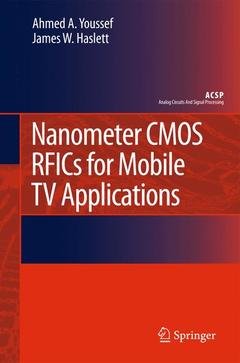Description
Nanometer CMOS RFICs for Mobile TV Applications, 2010
Analog Circuits and Signal Processing Series
Authors: Youssef Ahmed A., Haslett James
Language: English
Subject for Nanometer CMOS RFICs for Mobile TV Applications:
Keywords
CMOS; MOSFET; Mobile Television; Nanometer CMOS RFICs; RFIC; Symbol; system analysis
105.49 €
In Print (Delivery period: 15 days).
Add to cartPublication date: 09-2012
200 p. · 15.5x23.5 cm · Paperback
105.49 €
In Print (Delivery period: 15 days).
Add to cartPublication date: 06-2010
200 p. · 15.5x23.5 cm · Hardback
Description
/li>Contents
/li>Comment
/li>
Nanometer CMOS RFICs for Mobile TV Applications focuses on how to break the trade-off between power consumption and performance (linearity and noise figure) by optimizing the mobile TV front-end dynamic range in three hierarchical levels: the intrinsic MOSFET level, the circuit level, and the architectural level. It begins by discussing the fundamental concepts of MOSFET dynamic range, including nonlinearity and noise. It then moves to the circuit level introducing the challenges associated with designing wide-dynamic range, variable-gain, broadband low-noise amplifiers (LNAs). The book gives a detailed analysis of a new noise-canceling technique that helps CMOS LNAs achieve a sub - 2 dB wideband noise figure. Lastly, the book deals with the front-end dynamic range optimization process from the systems perspective by introducing the active and passive automatic gain control (AGC) mechanism.
Preface. List of Symbols and Abbreviation.- One: Introduction and Overview. 1.1 Mobile TV Architectures. 1.2 DVB-H Mobile TV System Definitions. 1.3 Scope of This Book.- Two: Wideband CMOS LNA Design Techniques. 2.1 Dynamic Range Limits in MOSFETs. 2.2 Traditional CMOS LNA Topologies. 2.3 Recent Trends in Wideband CMOS LNAs. 2.4 Techniques to Improve the Wideband LNA Dynamic Range. 2.5 Chapter Summary.- Three: Nanometer CMOS LNAs for Mobile TV Receivers. 3.1 Requirements of the LNA in Mobile TV Receivers. 3.2 A 65 nm CMOS Wideband LNA Prototype. 3.3 Experimental Results. 3.4 Chapter Summary.- Four: RF Attenuator Linearization Circuits. 4.1 The Necessity of RF Automatic Gain Control. 4.2 RF Gain Control System Analysis. 4.3 Highly Linear RF Front-End Architectures. 4.4 Design of the Binary Weighted RF Attenuator. 4.5 Practical Considerations. 4.6 A 65 nm CMOS RF Passive Attenuator. 4.7 Chapter Summary.- Five: Wide Dynamic Range Mobile TV Front-End Architecture. 5.1 Mobile TV Front-End with Automatic Gain Control. 5.2 A 65 nm CMOS RF Front-End Prototype. 5.3 Chapter Summary.- Six: Summary and Conclusions. 6.1 Summary and Conclusions. 6.2 Further Research Areas.- References. Index. Author Biographies.




